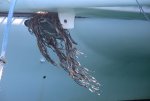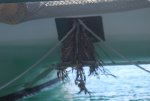NormanS
Well-Known Member
Jonathan, it must be wonderful to be able to guarantee that the wind in your anchorages never exceeds 30 knots. ?
Sadly, that doesn't work for us.
Sadly, that doesn't work for us.
Jonathan, it must be wonderful to be able to guarantee that the wind in your anchorages never exceeds 30 knots. ?
Sadly, that doesn't work for us.
I think maybe you tripped over a conversion factor. I got 1820 pounds for your boat.
The theory is right. And in fact I have also confirmed your reasoning with a load cell.
Convert HP to ft-#/s, get your reverse speed in ft/s, and divide. The 60% efficiency factor is reasonable, and even as low as 35% for some outboards. We can quibble over prop slip and hydrodynamics, but you're not far off. For example, based on my PDQ:
HP = 19.8 (twin Yamaha high reverse thrust)
Speed in reverse 7.3 knots
=(50%)10890/12.4=439 pounds.
For my F-24
HP=4
speed = 5
=(35%)2200/8.50=90 pounds.
In fact, reverse thrust on the PDQ is about 440-455 and 80 pounds with the F-24. Very close. Certainly not bad compared with the guesswork to come.
The next question is windage and waves. This is different for each boat, but if you take ABYC H-40 table 1 storm value, and use about 1/3 of that, that is you rode tension at about 42 knots. From there, F~ V^2 with wind. The highest gusts don't matter quite as much as the sustained wind, because the motion of the boat and catenary damps that, waves depend on sustained wind, and because the table is based on sustained winds.
[I have assumed that you have either a long snubber or a lot of chain and are NOT snubbing up on the rode at all. Also that the boat is not yawing more than about 20 degrees each side of the wind. Finally, that you are in water deep enough that the waves are not too steep. if any of these are false, the load can be LOT more.]
But this is a broad aproximation. A good answer requires a load cell. In general, backing the engine hard is similar to a strong gale.
I do anchor under sail from time to time.You do realise that CQR anchors have been on the go for rather longer than reliable "auxiliary" engines. That approach must have worked then.
I think you have a problem with the units. It's always easier to work with SI units, even if you have to convert them back at the end to relate to the original problem.
Relevant SI units:
Distance: metres
Speed: m/s
Energy (work): joules
Power: watts (j/s)
Mass: kg
Force: Newtons
I think you have a problem with the units. It's always easier to work with SI units, even if you have to convert them back at the end to relate to the original problem.
Relevant SI units:
Distance: metres
Speed: m/s
Energy (work): joules
Power: watts (j/s)
Mass: kg
Force: Newtons
Jonathan, it must be wonderful to be able to guarantee that the wind in your anchorages never exceeds 30 knots. ?
Sadly, that doesn't work for us.
I've no idea what you're getting at with your comment. Sadly, I think it's meant to be derogatory. If not, I apologise.Then use more engine.
Whiner.
I've no idea what you're getting at with your comment. Sadly, I think it's meant to be derogatory. If not, I apologise.
The fact is that in some of the more exposed parts of the world, winds are often strong, and there is a lack of vegetation, which might otherwise reduce the wind speed. Helpful comments are of course always welcome.
I've had my current boat for 19 years now, and in that time, once the anchor has grabbed and set, I've never had it drag using this method, not even when sitting-out hurricane Tomas in Antigua.Hmm, so you just drop the anchor and let it lie?
At least, when you dig in the anchor with reverse engine you will have an idea how good the holding power of the sea bed is.
And in the case of Spade anchor, which we have been using for years, it never has failed to adjust to changing wind directions and reset itself. So, I fully trust that aspect, but I still would like to know what the holding power is at some point...
I've had my current boat for 19 years now, and in that time, once the anchor has grabbed and set, I've never had it drag using this method, not even when sitting-out hurricane Tomas in Antigua.
We used to laugh our heads off in the Solent (especially in Newtown Creek) when boats would come in, chuck their anchor out, and throw it into reverse, only to find that that they have ploughed right across the creek and then they have to lift their anchor up and try again. On one occasion, we watched someone do this half a dozen times and then give up and go to Yarmouth instead.
If you let the anchor set on its own, it is less likely to plough a trough, and once it is dug in, it will keep digging itself in slowly with the wind, tide, and motion of the boat. There is absolutely no need to use reverse other than maybe in tick-over to help it get a grip in light wind conditions.


These are interesting photos. It must be a nightmare to clear weed etc from an anchor on a catamaran like that. How do you get access to clear it? Do you have to partially unrig the trampoline netting?I have sat and watched people lose swim suits, towels (and even some folding chairs) not to mention beer cans in anchorages. More often than not the offending articles are never retrieved. We have heard of people catching crab pots and supermarket trolleys - and we once caught a 5kg gas cylinder.
If you anchor catches any of these items your anchor will not set - if you simply chuck the anchor over the side in relatively calm conditions you will not know it is fouled unless you try it. You can wait for the wind to pick up, but that might not happen till 2am. It does seem ever so simple to put the line in reverse.
Modern anchor can have a sharp toe - sharp enough to catch more natural items, seaweed or a shell - again - instead of waiting for the wind to pick up - reverse is so much predictable.
These anchors might 'set' but will never offer reliable hold as they simply cannot set deeply - how are you going to find out - unless you test them to near maximum of your yacht's ability to check the hold? Both of these anchors are under the bridge deck of two different catamarans, a common location for the bow roller. You cannot easily see that the anchors have been fouled.
View attachment 128698
View attachment 128699